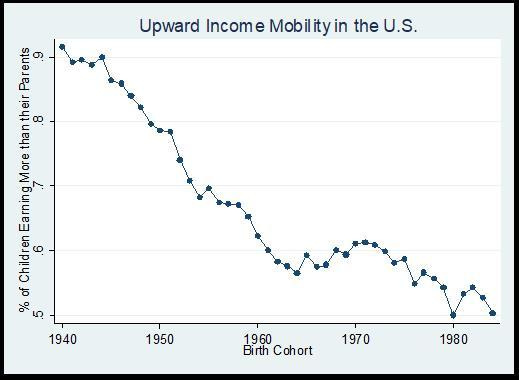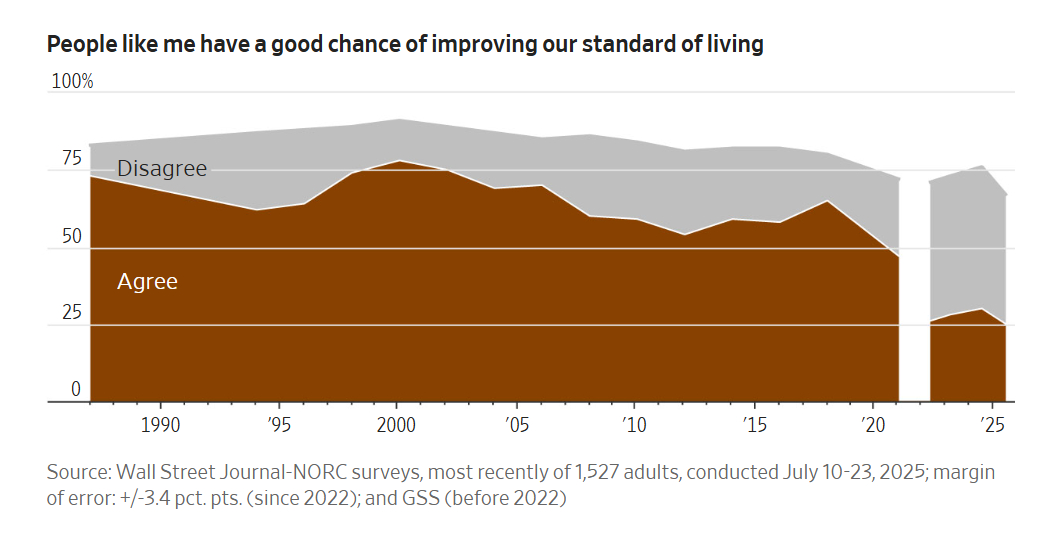The American Dream is Dead
But was it ever the right dream?

It’s easier than you might think to quantify the death of a dream. A recent study shows that nearly 70% of the United States no longer has faith in the American Dream, while a new analysis concludes that reaching the traditional pillars of the dream now cost $5 million. Measured both by belief, which is necessary to sustain a dream, and by the material mountain you need to climb to reach this particular dream, it’s clear that the once alluring and achievable vision of American life is now dead.
In Lindsay Ellis and Aaron Zitner’s recent write up of the new WSJ survey about the American Dream, they cite plenty of data. They tell us that only 25% of people now think they have a good chance of improving their standard of living. They tell us that even fewer people think the next generation will have it better than we do. But then they tell us stories, stories of how conditions have changed. And none of their anecdotes hit harder than the following paragraph:
“While Jeff Lindly, 61, said he believes the economy is improving slowly, his adult children’s experience in the housing market draws a contrast with his own. Lindly was able to earn enough to support his wife and family when his children were young. They bought a house and, later, built two more. Now, two of his three adult children live with him in Godley, Texas, one in a trailer on the property and one with her husband and child in the home.”
Our reality is stark; faith in the American Dream has evaporated with good reason. While the cost of the core tenets of the life we were promised, like owning a home and a new car and a comfortable retirement, has skyrocketed, most of the population no longer has the economic mobility to keep up. This has been a long time coming. As Raj Chetty and his colleagues recently showed, more than 90% of children born in 1940 went on to earn more than their parents did — itself a cornerstone assumption of the American dream — but children born in the 1980s only have a 50-50 chance of doing better than their parents. And that number is only declining with time.
At this very moment our prospects look even worse than they did in the Reagan era, and the faith in the future that underpins much of our economy, that leads corporations to invest and consumers to spend, is tanking. Right now 77% of workers are worried about the economy. The $5 million price tag of the American Dream is out of reach for 99% of us. Tariffs and inflation and the job market mean that most people who have a job are simply clinging to it, while people without jobs are struggling to find them. The number of unemployed people just surged past the number of job openings for the first time since the height of the pandemic. At this juncture alarm bells are going off about the health of the economy, not only because of short-term problems but because of underlying structural issues that have long gone unaddressed.
The reality is that the loss of faith in the American Dream is an utterly rational response to an economic picture where the vast majority of people are left behind while a small subset amasses unfathomable wealth. We see the three richest men in the country hoard $1 trillion while millions are kicked off their healthcare. We see the President and his family build a multi-billion dollar crypto fortune while they defund education. We see more and more homeless people every year, while most political leaders have no serious interest in addressing the problem. Losing faith in the American Dream is a rational response to reality.
But what was the dream? What is the dream? A house in the suburbs, two cars in the garage, a golden retriever? This picture is a little hokey, but it does sum up the vision we were sold. Vacations, a lavish wedding, retirement on the beach — we were given an image of the life an American was supposed to aspire to, and supposed to be able to reach. But our current reality is so far from this picture that countless young people talk about never owning a home and never being able to retire. And it’s not a joke; while their parents or grandparents had guaranteed pensions, millions of young folks don’t even have 401Ks, not to mention the cost of a home being more than twice what it was just 20 years ago.
So the dream is out of reach, and people are trying to adjust to our new reality. Both the money and the faith that powered the American Dream have been sucked away by the ruling class. But in every calamity lies some sort of opportunity, and today we have the opportunity to examine the dream. Millions of people who might have once pursued it in a frenzy have given up on it, and that gives us the chance to step back and look it over. And what we might find is that we can come up with something better than a gilded, secluded, suburban life.
The American Dream was always about status and cash, not happiness or well-being. The new car, the picket fence, the nice vacations: we were sold these specific ideas, these specific purchases, but underneath them was the idea that we could go from being temporarily embarrassed millionaires to actually reaching the top of the heap. Decades of propaganda convinced us that until we reached that milestone, until we had every material comfort and status symbol, we didn’t have enough. No rest for the weary, no rest for the workers — not until you have everything plus the icing on top.
And that’s no way to live. As the American Dream is dying, we can safely say that it was pointing us in the wrong direction, it was telling us to run toward isolation and away from community. It was telling us to run toward our jobs and away from family and friends. We were told to care more about two brand new cars and low taxes than a society we actually enjoyed living in. Never mind the fact that most non-white people and women were tacitly, or explicitly, excluded from the dream for most of its existence.
So while the staggering economic inequality that got us here and the recession that seems to circle closer by the day are both infuriating and frightening, we can and should understand the silver lining here. Namely, we have a vital and rare opportunity to deliberately aim for a different dream. Structural problems in society that developed over decades have reached a ripping point in recent years. The problems of individualism, the erosion of the social safety net, the isolation and alienation of work under capitalism, all of it has come to a head. Perhaps nothing revealed this cancerous mass of underlying problems like covid. In 2020 about 50% of Americans agreed with the statement: “people like me have a good chance of improving our standard of living.” By 2022 that number had rapidly fallen by half, and it still hovers around 25% today:
So now we can see that the American Dream is no more, and that in the death of one dream we have the opportunity to build another. As people accept that a house in the suburbs, a picket fence, and shiny new cars are out of reach we can reach for something else, collectively. At first this shift might come because it’s being forced on us, at first it might come because we’ve been denied the future that was promised to us and are instead living in a time of massive inequality and growing hardship. But, in time, our anger and frustration about this state of affairs can build into clarity. In time more and more people will see that owning a McMansion wasn’t a terribly beautiful dream to begin with. More and more people will see that we can imagine better, can imagine community and happiness instead of isolation and property.
Much of our initial work is translation. Right now the loss of faith in the future, in progress, and in America looks primarily like cynicism and anger. And when three men hoard one trillion dollars while millions suffer those feelings are more than understandable, more than justified. But we need to move beyond just being jaded, beyond being just atomized units of rage. We need to translate the death of the American Dream into something new, into a vision where everyone has what they need and where we dream of new world together instead of seeking to carve out a pocket of a dying world for ourselves. Then we need to build this new dream into a new reality. We can have a world where no one profits off our needs, where decisions are made collectively, where we control our destinies instead of being controlled. We can have real freedom, real prosperity, real democracy, but we have to let the old dream die, and dream of something much greater. - JP




"And when three men hoard one trillion dollars ... "
How long before Americans finally catch on that this is the real problem they face? That what has killed the American dream is unchecked, unimaginable avarice?
My fear is that the American dream of a house, car, and 2.5 kids will be replaced by a different and yet also familiar American dream (fascism)